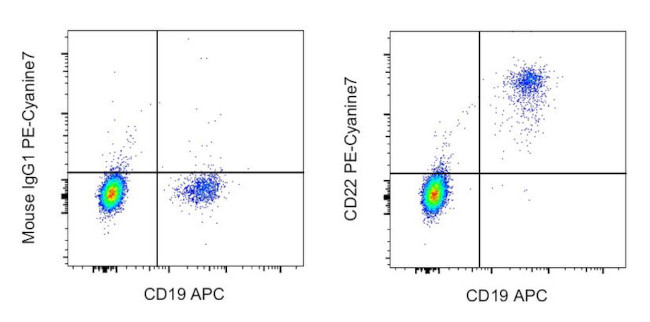Search Thermo Fisher Scientific
图: 1 / 1
CD22 Antibody (25-0229-42) in Flow

产品信息
25-0229-42
种属反应
宿主/亚型
分类
类型
克隆号
偶联物
激发/发射光谱
形式
浓度
纯化类型
保存液
内含物
保存条件
运输条件
RRID
产品详细信息
Description: The eBio4KB128 monoclonal antibody recognizes human CD22 (Siglec-2), which is a member of the siglec subgroup of the Ig superfamily. CD22 is a type I transmembrane glycoprotein composed of two polypeptide chains, CD22alpha and CD22beta, of 130 and 140 kDa respectively, produced by alternative splicing of the CD22 gene. CD22 is expressed at high levels on mature B cells and B cell lymphomas. The extracellular portion of CD22 contains seven Ig-like domains, some of which are capable of binding ligands with sialic acid moieties expressed on epithelial, endothelial, B and T cells. The intracellular portion of CD22 contains 6 tyrosine residues contained within immunotyrosine-based inhibitory motifs (ITIM) and immunotyrosine-based activation-like motifs, which are phosphorylated upon B-cell receptor engagement, which enables CD22 to participate in the positive and negative regulation of B-cell receptor signaling.
Applications Reported: This eBio4KB128 (4KB128) antibody has been reported for use in flow cytometric analysis.
Applications Tested: This eBio4KB128 antibody has been pre-diluted and tested by flow cytometric analysis of normal human peripheral blood cells. This may be used at 5 µL (0.25 µg) per test. A test is defined as the amount (µg) of antibody that will stain a cell sample in a final volume of 100 µL. Cell number should be determined empirically but can range from 10^5 to 10^8 cells/test.
Light sensitivity: This tandem dye is sensitive to photo-induced oxidation. Please protect this vial and stained samples from light.
Fixation: Samples can be stored in IC Fixation Buffer ((Product # 00-8222-49)) (100 µL of cell sample + 100 µL of IC Fixation Buffer) or 1-step Fix/Lyse Solution ((Product # 00-5333-57)) for up to 3 days in the dark at 4°C with minimal impact on brightness and FRET efficiency/compensation. Some generalizations regarding fluorophore performance after fixation can be made, but clone specific performance should be determined empirically.
Excitation: 488-561 nm; Emission: 775 nm; Laser: Blue Laser, Green Laser, Yellow-Green Laser.
靶标信息
CD22 (BL-CAM) is a type 1 integral membrane glycoprotein with molecular weight of 130 to 140 kDa. CD22 is expressed in both the cytoplasm and cell membrane of B-lymphocytes. CD22 antigen appears early in B-cell lymphocyte differentiation at approximately the same stage as the CD19 antigen. Unlike other B-cell markers, CD22 membrane expression is limited to the late differentiation stages comprised between mature B cells (CD22+) and plasma cells (CD22-), and may thus prove useful in phenotyping mature leukemias. CD22 is also strongly expressed in hairy cell leukemia. CD22 preferentially binds to alpha2,6-linked sialic acid. The sialic acid recognition site can be masked by cis interactions with sialic acids on the same cell surface. Upon ligand induced tyrosine phosphorylation in the immune response seems to be involved in regulation of B cell antigen receptor signaling. CD22 plays a role in positive regulation through interaction with Src family tyrosine kinases and may also act as an inhibitory receptor by recruiting cytoplasmic phosphatases via their SH2 domains that block signal transduction through dephosphorylation of signaling molecules. CD22 is also strongly expressed in hairy cell leukemia. CD22 is also positive in diffuse large B-cell lymphoma and nodular lymphocyte predominance Hodgkin’s lymphoma, but negative in classical Hodgkin’s lymphoma.
仅用于科研。不用于诊断过程。未经明确授权不得转售。
How to use the Panel Builder
Watch the video to learn how to use the Invitrogen Flow Cytometry Panel Builder to build your next flow cytometry panel in 5 easy steps.
篇参考文献 (0)
生物信息学
蛋白别名: B-cell receptor CD22; B-lymphocyte cell adhesion molecule; B-lymphocyte cell adhesion molecule (BL-CAM); BL-CAM; CD22; CD22 antigen; FLJ22814; Lectin 2; Leu-14; MGC130020; sialic acid binding Ig-like lectin 2; Sialic acid-binding Ig-like lectin 2; Sialic acid-binding Ig-like lectin 2 (Siglec-2); Siglec-2; T-cell surface antigen Leu-14
基因别名: CD22; SIGLEC-2; SIGLEC2
UniProt ID: (Human) P20273
Entrez Gene ID: (Human) 933




